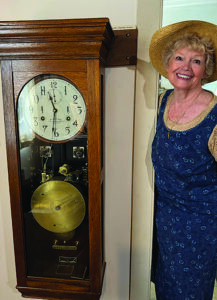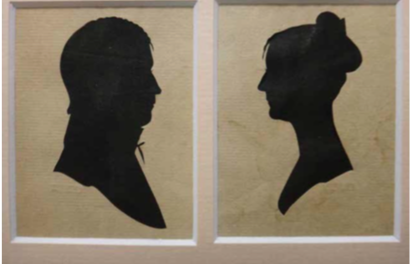(Editor’s note: DeeDee Wood is the owner of Black Cat Curiosities, an online antiques research and sales venue.)

Elizabeth Ferguson, president of the Trappe Rural Life Museum, stands next to the old Trappe High School Master Program Clock in the Defender House of the complex. (Photo by DeeDee Wood)
Elizabeth Ferguson, president of the Trappe Rural Life Museum, met me at the entrance to their main building on the farm campus, just outside Trappe, Md.
Large shade trees invited me further into the property, where old rural buildings whispered tales through the summer heat of yesteryear. She was excited to show me the campus and history that sit on a property a little over two acres in size, sitting just outside of the town.
A sign with an arrow is prominently displayed for traffic driving by the location on US Route 50, a major vein of transportation in the area, as you make your way south down the Eastern Shore.
The Rural Life Museum’s mission is issued in the following statement in a brochure found on the property. “We collect, preserve, interpret and display a broad array of historically significant items, pictures, and documents including many used in rural homes, farms and industry in Trappe so they can be shared.”
Ferguson showed me around campus, showcasing each rural building and structure and what they are used for today, and in the past.
Among and within the buildings on campus, which also include, of course, antiques of the region, artifacts and story boards, are also representations of a rural life of the area. Tools, canning equipment, farm implements and more are displayed in the buildings around campus.
The Defender House, the museum’s main building, is a rural farm house from circa 1815, with one room downstairs and displays about the region, including clocks, a banjo, artifacts, such as old radios and household tools from yesterday, and more.
The cases in this room house folk art, old irons, kitchen tools and things used in rural domestic life.
“Different people lived here over the years from this area, and this was their home,” Ferguson said, guiding me around to various photos on the wall of local people and their stories.
This main house also has stories of people who spent their lives in Trappe, or were from the region, and have historic stories to tell.
Among many historical figures that include locals from many walks of life, story boards showcase local soldiers and hometown heroes and their stories of bravery, a display dedicated to Frank “Home Run” Baker, a professional baseball player who played for the Philadelphia Athletics and New York Yankees in the early 1900s, John Dickinson, “Penman of the American Revolution,” who was born in the Trappe area and later lived in Delaware, and Nace Hopkins, an enslaved man from the region who served as a soldier in the Union Army during the American Civil War, and later helped build community by originating the annual Trappe Emancipation Day. He also helped establish the first African American school in the Trappe area, and was a founder of the Scotts Methodist Church in the region. His life and work are well documented in this museum, as well as displays on the Defender House itself.
The Defender House also displays a special restored clock, the “Trappe High School Master Program Clock, 1927-2024.”
The clock, which is a master clock from the high school that controlled all of the bells in the old high school, was thought lost to time after the high school was demolished in 2006, but lives again in the Rural Life Museum, and has been proudly restored to its original working order. There is a detailed pamphlet on the clock at the museum, to inform the visitor of restoration work and results.
The museum also houses the Scale House (circa 1920), a place where grain was measured and produce was weighed, which is accompanied by old tools of the trade and machinery and cans of that era, the Carriage House (circa 1900), which is now the museum’s gift shop, offering neat t-shirts, mugs and other merchandise, and the Smokehouse (circa 1890), which houses old rural farms tools and farm implements.
Each has interpretation, old antiques and artifacts and were all moved to the property, along with the Defender House, from other parts of the surrounding Trappe rural area, in an effort to preserve and interpret rural history of the region. One last thing of interest for this museum is a skill that someone can offer.
Ferguson said that “one of our board members is trained in graphoanalysis, and is willing to examine handwriting to give members possible new insight into the character of their ancestors,” which is an intriguing path for history interpretation, for sure!
The Rural Life Museum in Trappe is located at 29241 BacktownRoad, and is open the second Saturday of each month, or by appointment.
Ferguson indicated some festivals and programs are in the works for this year, and you can contact them or visit their social media pages or website for more information about upcoming events.
To become a member of this organization, and support its efforts, visit www.trapperurallifemuseum.org, or call 443-477-3537.




